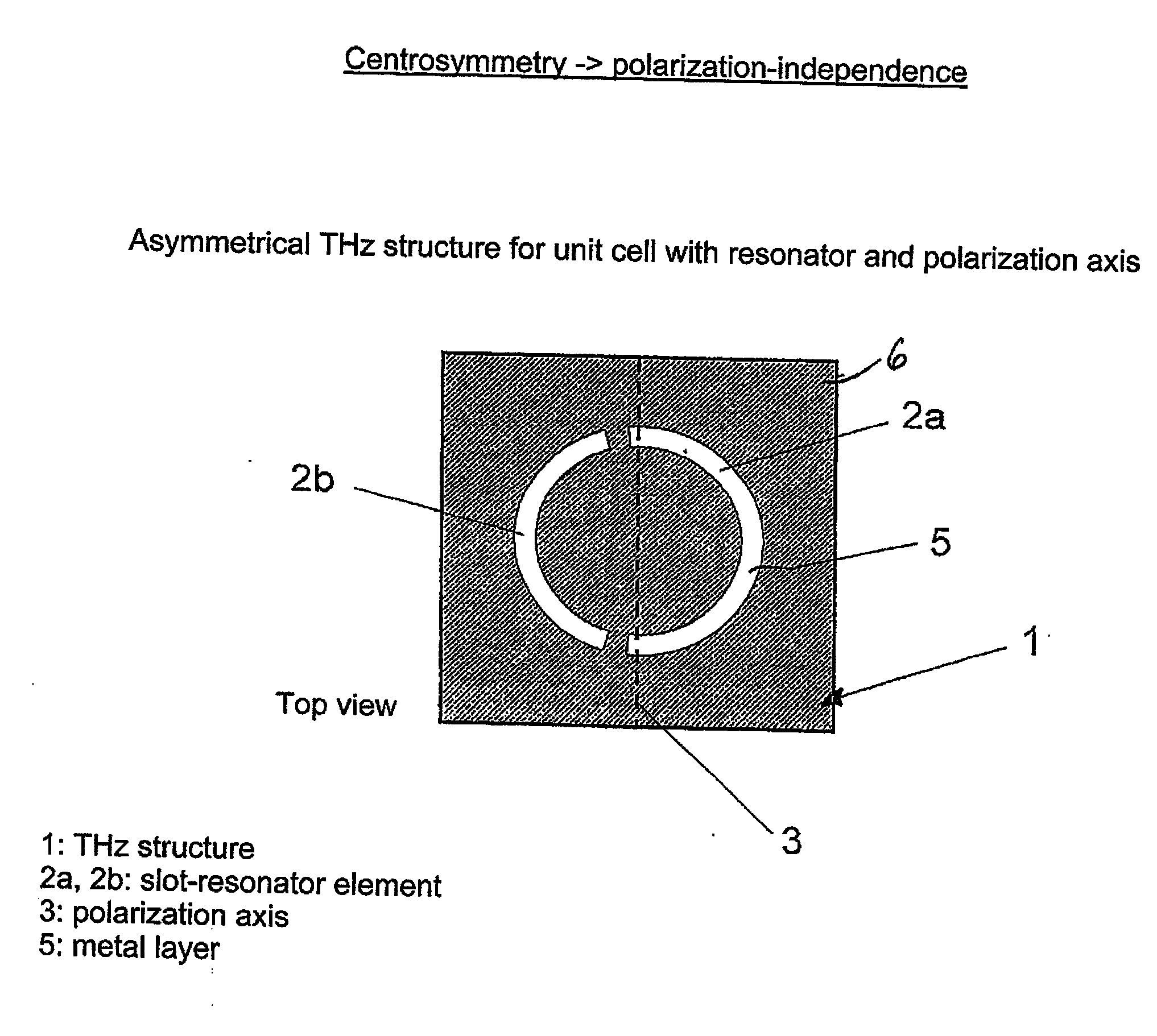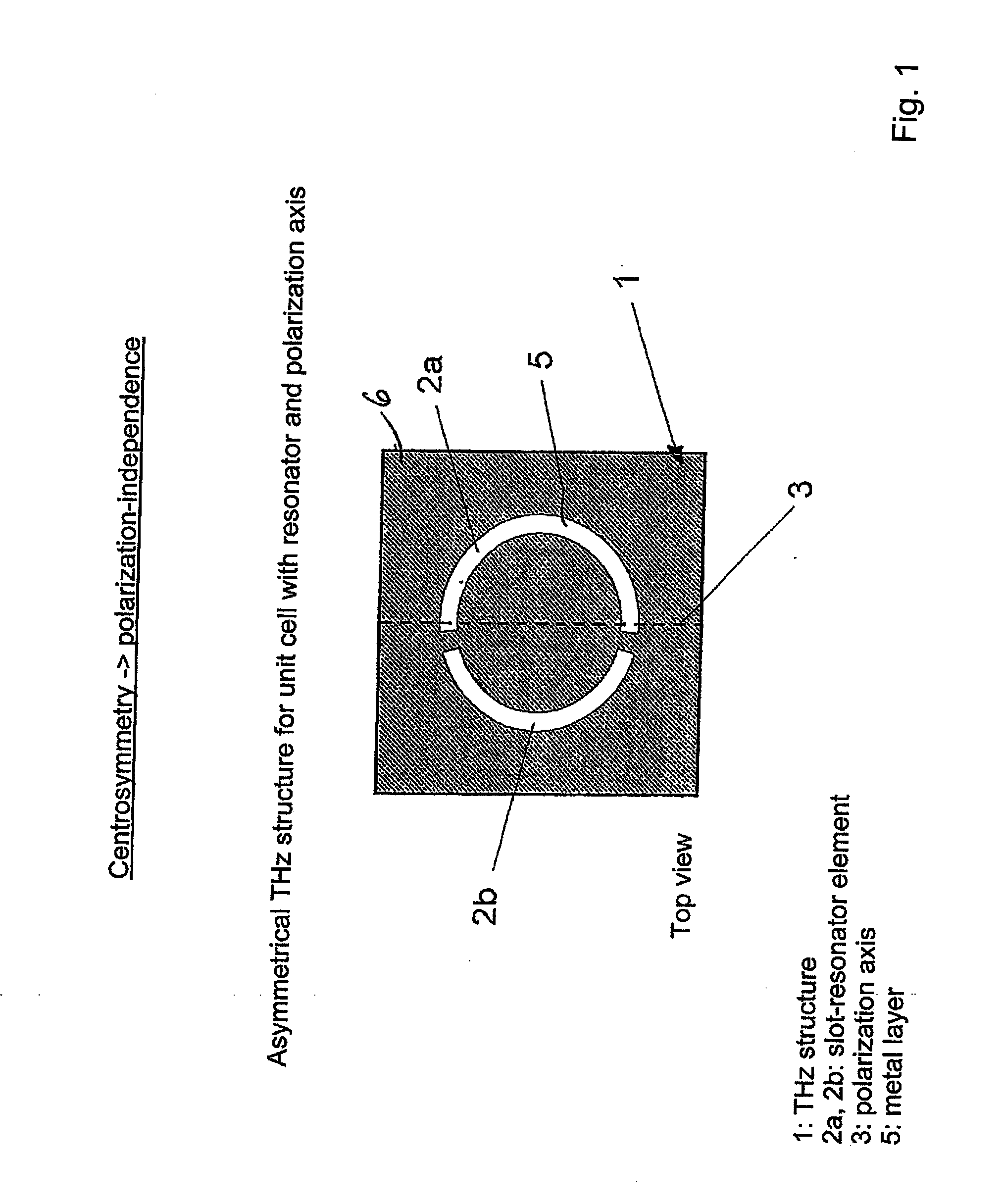Production method for a surface sensor, system and use of a surface sensor
- Summary
- Abstract
- Description
- Claims
- Application Information
AI Technical Summary
Benefits of technology
Problems solved by technology
Method used
Image
Examples
first embodiment
[0081]FIG. 3 shows a surface sensor 100 in which a THz structure 1 in the form of a metal layer 5 is applied to a substrate 6 in the form of a dielectric material in the usual manner.
[0082]In a further development of this first embodiment, a second embodiment of a surface sensor 200 shown in more detail in FIG. 4 may be realized, in which a part of the substrate 6 is removed. Thereby, an edge, in the present case a slot edge 8 of the metal layer 5, is released relative the substrate 6 in a particularly advantageous manner. This can be advantageously achieved by undercutting the metal layer 5 in the area of the edge.
[0083]The releasing of the edge 8 enables the resonance characteristics of the THz resonance structure 1 to be determined largely independent of the substrate. Moreover, a field magnification forms in the area of the edge which makes the THz resonance structure 1 in this important area thereof sensitive with respect to deposited molecules or the like to be detected.
second embodiment
[0084]FIG. 7 shows a third further embodiment of a modified THz structure 300 as compared to the second embodiment illustrated in FIG. 4. For the remainder, identical reference numerals have been used here for identical or similar features, respectively features having the same or an identical function.
[0085]In extension of the second embodiment, the metal layer 5 in the surface sensor 300 is covered by a non-precious metallic passivation layer 9 which suppresses or prevents chemical binding of the capture molecules. In the present case, the passivation layer 9 is applied to the metal layer 5 prior to the undercutting to release the slot edge 8. The passivation layer 9 in the form of a non-precious metallic layer is hence removed by being etched away together with the not further described metal layer 5 for forming the THz structure on the substrate 6 in regions 7 outside the THz structure, with the slot edge 8 thereby being released at the same time.
[0086]FIG. 8 shows a further mod...
fourth embodiment
[0088]The third as well as FIGS. 7 and 8 ensures that capture molecules as shown in the area 9a will only bind in the immediate area of the undercut slot edge 8 of the metal layer 5. The discussed application of the passivation layer 9, 11 will namely prevent an interaction between the capture molecules and the metal layer 5, respectively will only be possible in the area of the edge 8.
[0089]In summary, the invention relates to a surface sensor 100, 200, 300, 400, comprising a frequency-selective surface with periodically arranged THz structures 1 sensitive to THz radiation, in particular THz resonator structures 1, each having an associated polarization axis 3. In order to improve remote field characteristics, the invention provides for the asymmetrical configuration of a THz structure 1, and a group of two or more THz structures to have essentially centrosymmetrically aligned polarization axes for forming a unit cell.
PUM
 Login to View More
Login to View More Abstract
Description
Claims
Application Information
 Login to View More
Login to View More - R&D
- Intellectual Property
- Life Sciences
- Materials
- Tech Scout
- Unparalleled Data Quality
- Higher Quality Content
- 60% Fewer Hallucinations
Browse by: Latest US Patents, China's latest patents, Technical Efficacy Thesaurus, Application Domain, Technology Topic, Popular Technical Reports.
© 2025 PatSnap. All rights reserved.Legal|Privacy policy|Modern Slavery Act Transparency Statement|Sitemap|About US| Contact US: help@patsnap.com



